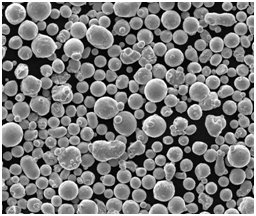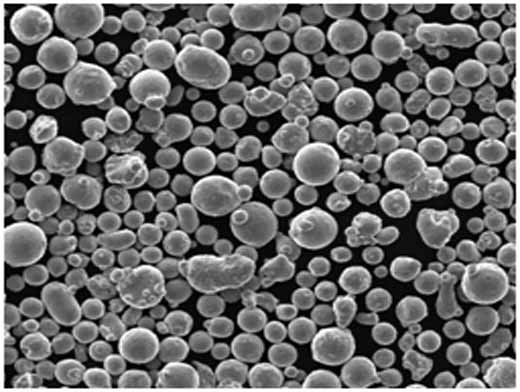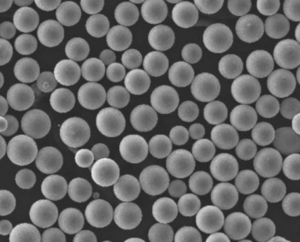Visión general de Stellite 21 Polvo
El polvo de Stellite 21 es una aleación a base de cobalto conocida por su extraordinaria resistencia al desgaste, la corrosión y las altas temperaturas. Desarrolladas originalmente por Elwood Haynes a principios del siglo XX, las aleaciones Stellite se han convertido en vitales en industrias que requieren durabilidad en condiciones extremas. La Stellite 21, en particular, destaca por su impresionante equilibrio entre dureza, tenacidad y resistencia a la corrosión. Se utiliza a menudo en aplicaciones relacionadas con herramientas de corte, válvulas, motores de turbina y revestimientos de alto rendimiento, y es una de las mejores opciones para prolongar la vida útil de los componentes en entornos abrasivos y de alta tensión.
En este artículo, le explicaremos todo lo que necesita saber sobre el polvo de estelita 21: desde su composición, características, ventajas y desventajas, hasta sus diversas aplicaciones, modelos, especificaciones, proveedores y precios. Analicemos qué hace que este polvo metálico sea imprescindible en la industria pesada y en otros sectores.

¿Qué es el polvo Stellite 21?
El polvo de Stellite 21 es principalmente una aleación de cobalto y cromo, que se mejora con pequeñas cantidades de otros elementos como molibdeno y níquel para proporcionar resistencia adicional y características de rendimiento. Es ampliamente reconocida por su capacidad para conservar la dureza incluso a altas temperaturas y en entornos corrosivos. La aleación se utiliza normalmente en forma de polvo para aplicaciones de revestimiento como la pulverización térmica, el revestimiento por láser o la fabricación aditiva en lecho de polvo.
Stellite 21 Composición del polvo
El núcleo del polvo de Stellite 21 es su equilibrada composición química, que le confiere sus propiedades distintivas.
| Elemento | Composición porcentual |
|---|---|
| Cobalto (Co) | 55-60% |
| Cromo (Cr) | 27-30% |
| Molibdeno (Mo) | 4.5-6% |
| Níquel (Ni) | 2-3% |
| Hierro (Fe) | <3% |
| Carbono (C) | 0.20-0.30% |
| Silicio (Si) | <1% |
| Manganeso (Mn) | <1% |
Como puede verse en la tabla anterior, el cobalto constituye la mayor parte de la aleación, mientras que el cromo aporta la resistencia vital a la corrosión y la oxidación. El molibdeno mejora aún más la resistencia del material a las picaduras, lo que lo convierte en una opción adecuada para entornos operativos difíciles.
Características de Stellite 21 Polvo
- Resistencia al desgaste: Gracias a su base de cobalto, el polvo de Stellite 21 es famoso por su excelente resistencia al desgaste. Resiste bien la abrasión, el gripado y la erosión, por lo que es perfecto para aplicaciones de alto desgaste.
- Resistencia a la corrosión: El alto contenido de cromo permite que la aleación resista la corrosión, incluso en entornos químicamente agresivos, incluidos los que contienen azufre y cloro.
- Estabilidad a altas temperaturas: Una de las características únicas del polvo de Stellite 21 es su capacidad para mantener la dureza y la resistencia a temperaturas elevadas (hasta 950°C). Esta propiedad la hace muy deseable para componentes de motores de turbina e intercambiadores de calor.
- Equilibrio entre dureza y tenacidad: A diferencia de algunos materiales más duros que tienden a ser quebradizos, la Stellite 21 consigue un buen equilibrio entre tenacidad y dureza, garantizando la durabilidad bajo tensiones de impacto.
Aplicaciones del polvo de estelita 21
El polvo de estelita 21 se utiliza en diversos sectores en los que la durabilidad y el rendimiento en condiciones duras son requisitos clave. Desde la industria aeroespacial hasta los implantes médicos, aquí es donde deja su huella:
| Industria | Solicitud |
|---|---|
| Aeroespacial | Álabes de turbina, intercambiadores de calor, toberas de combustible |
| Petróleo y gas | Asientos de válvulas, brocas, componentes de bombas |
| Automotor | Piezas de motor de alto rendimiento, árboles de levas |
| Productos sanitarios | Implantes ortopédicos, instrumental quirúrgico |
| Generación de energía | Turbinas de vapor y gas, componentes de calderas |
| Minería y movimiento de tierras | Placas de desgaste, molinos, piezas de trituradoras |
| Ingeniería naval | Ejes de hélices, válvulas marinas, hélices de bombas |
¿Por qué se utiliza el polvo de estelita 21 en estas aplicaciones?
- Aeroespacial: La capacidad de esta aleación para mantener la resistencia mecánica a altas temperaturas la hace esencial en los motores de turbina, que funcionan a temperaturas y presiones extremas. Su resistencia a la corrosión garantiza su longevidad en entornos tan exigentes.
- Petróleo y gas: Las condiciones duras y químicamente agresivas que se dan en la perforación y extracción de petróleo requieren un material como la Stellite 21 que resista el desgaste y la corrosión. Componentes como los asientos de las válvulas están sometidos a grandes esfuerzos y a los efectos erosivos de los fluidos y los gases, por lo que esta aleación es la opción ideal.
- Ámbito médico: Debido a su biocompatibilidad y resistencia al desgaste, el polvo de estelita 21 se emplea con frecuencia en la fabricación de implantes ortopédicos y herramientas quirúrgicas duraderas. Ofrece una vida útil más larga en comparación con otros materiales.
Comparación de diferentes modelos de polvo metálico para la estelita 21
Al elegir polvos de Stellite 21 para una aplicación concreta, puede encontrarse con varios modelos, cada uno de ellos adecuado para procesos específicos como el revestimiento por láser, la pulverización de plasma o la fabricación aditiva.
Modelos comunes de polvo de estelita 21 y sus descripciones
| Modelo | Descripción |
|---|---|
| Stellite 21-G | Polvo fino, más adecuado para procesos de pulverización térmica |
| Stellite 21-LC | Específicamente diseñado para el revestimiento por láser, proporciona una excelente fuerza de adherencia |
| Satélite 21-AM | Optimizado para la fabricación aditiva, garantiza una deposición de capas uniforme |
| Stellite 21-HP | Polvo de alto rendimiento utilizado en técnicas de pulverización de plasma para aplicaciones de revestimiento |
| Stellite 21-HVOF | Se utiliza en la pulverización de oxicombustible a alta velocidad (HVOF) para obtener revestimientos densos |
| Stellite 21-PW | Polvo grueso, preferido para soldadura con polvo y soldadura por arco transferido por plasma |
| Stellite 21-SC | Polvo de recubrimiento estándar para protección general contra el desgaste y la corrosión |
| Stellite 21-SP | Polvo superfino ideal para sinterizado láser y fusión de lecho de polvo |
| Stellite 21-AP | Polvo de uso general diseñado para el recubrimiento de piezas aeroespaciales y de automoción |
| Stellite 21-M | Diseñado para procesos de moldeo por inyección de metal (MIM) de alto rendimiento |
Cada uno de estos modelos está formulado para responder a necesidades específicas dentro de distintos procesos de fabricación y revestimiento. Por ejemplo, Stellite 21-LC está optimizado para el revestimiento por láser, garantizando una fuerte unión metalúrgica, mientras que Stellite 21-HP funciona excepcionalmente bien en técnicas de pulverización de plasma, proporcionando revestimientos de alta densidad.






Ventajas del polvo Stellite 21
- Excepcional resistencia al desgaste: La Stellite 21 es prácticamente inigualable en lo que se refiere a resistencia al desgaste en aplicaciones de alto esfuerzo. Esta característica por sí sola la hace inestimable en industrias como la aeroespacial y la del petróleo y el gas.
- Alta resistencia a la corrosión: La aleación puede resistir la corrosión en entornos en los que otros materiales, incluidos algunos aceros inoxidables, pueden fallar. Esto la hace ideal para aplicaciones en las que el contacto con productos químicos es frecuente.
- Estabilidad térmica: Incluso a altas temperaturas (hasta 950°C), la Stellite 21 conserva sus propiedades mecánicas. Esto es especialmente importante para turbinas y motores que funcionan a temperaturas extremas.
- Biocompatibilidad: Al no reaccionar negativamente con los tejidos biológicos, se utiliza en implantes médicos, ofreciendo tanto durabilidad como compatibilidad con el cuerpo humano.
Ventajas e inconvenientes
| Ventajas | Desventajas |
|---|---|
| Gran resistencia al desgaste en entornos abrasivos | Caro en comparación con otras alternativas de acero inoxidable |
| Excelente rendimiento a altas temperaturas | Requiere técnicas especializadas para su procesamiento |
| Resistencia superior a la corrosión en condiciones duras | Puede requerir un tratamiento posterior para obtener propiedades óptimas |
| Biocompatible para aplicaciones médicas | Posibilidad de fragilidad bajo fuertes impactos |
Comparación del polvo de Stellite 21 con otros polvos metálicos
Para entender mejor por qué destaca el polvo de Stellite 21, comparémoslo con otros polvos metálicos comunes como Inconel 625, carburo de tungsteno y Hastelloy C-276.
Polvo de Stellite 21 frente a Inconel 625
- Resistencia al desgaste: La resistencia al desgaste de la Stellite 21 es superior a la de la Inconel 625, especialmente en entornos abrasivos.
- Resistencia a la corrosión: Aunque ambos materiales ofrecen una buena resistencia a la corrosión, el Inconel 625 se comporta mejor en entornos con altas concentraciones de cloruro.
- Estabilidad a altas temperaturas: La Stellite 21 destaca en aplicaciones en las que la resistencia al desgaste a altas temperaturas es crucial, mientras que la Inconel 625 es más adecuada para la resistencia a la oxidación.
Polvo de estelita 21 frente a carburo de wolframio
- Dureza: El carburo de wolframio es más duro, pero la estelita 21 proporciona mayor tenacidad y es menos quebradiza bajo tensiones de impacto.
- Coste: El carburo de wolframio es más rentable para algunas aplicaciones de desgaste, pero carece de la versatilidad y resistencia a la corrosión de la estelita 21.
Polvo de estelita 21 frente a Hastelloy C-276
- Resistencia a la corrosión: Ambos polvos ofrecen una excelente resistencia a la corrosión, pero el Hastelloy C-276 puede funcionar mejor en entornos muy ácidos.
- Estabilidad térmica: La estelita 21 es la preferida en aplicaciones de desgaste a alta temperatura, mientras que el Hastelloy C-276 se utiliza principalmente para la protección contra la corrosión a temperaturas más bajas.
Especificaciones, tamaños y normas de la Stellite 21 en polvo
Dependiendo de la aplicación específica, el polvo de estelita 21 se presenta en diversos grados, tamaños y especificaciones. A continuación se indican las gamas de tamaños y normas típicas.
| Especificación | Descripción |
|---|---|
| Tamaño del polvo | 15-53 µm, 45-106 µm, 53-150 µm |
| Normas de fabricación | ASTM F75, AMS 5385, AMS 5796 |
| Densidad | 8,4 g/cm³ |
| Punto de fusión | 1315-1450°C |
| Dureza (HRC) | 30-40 HRC (según depósito) |
Dónde comprar Stellite 21 Polvo y precios
Varios proveedores suministran polvo de Stellite 21 en todo el mundo. Los precios pueden variar en función de la cantidad requerida y del modelo de polvo específico.
| Proveedor | País | Precio (por kg) | Notas |
|---|---|---|---|
| Höganäs AB | Suecia | $200-$250 | Ofrece una amplia gama de modelos en polvo |
| Carpenter Technology Corp | EE.UU. | $180-$230 | Especializada en formulaciones en polvo a medida |
| Oerlikon Metco | Suiza | $220-$270 | Ofrece soluciones de fabricación aditiva |
| Tecnologías de superficie Praxair | EE.UU. | $190-$240 | Conocida por sus polvos de recubrimiento de alta calidad |
| VDM Metales | Alemania | $210-$260 | Ofrece envío y entrega en todo el mundo |
Los precios varían en función de la forma del polvo, el modelo y el tamaño del pedido.

preguntas frecuentes
| Pregunta | Respuesta |
|---|---|
| ¿Para qué se utiliza el polvo de Stellite 21? | Se utiliza para revestimientos, fabricación aditiva y producción de piezas metálicas en entornos de alto desgaste. |
| ¿Es biocompatible Stellite 21? | Sí, se utiliza a menudo para implantes médicos debido a su excelente biocompatibilidad. |
| ¿Puede mecanizarse la Stellite 21? | Sí, pero el mecanizado de Stellite 21 requiere herramientas y técnicas específicas debido a su dureza. |
| ¿Cuál es el punto de fusión de la Stellite 21? | El intervalo de fusión se sitúa entre 1315-1450°C. |
| ¿Cómo se compara Stellite 21 con otras aleaciones de Stellite? | La Stellite 21 ofrece un mejor equilibrio entre tenacidad y dureza en comparación con algunas de las aleaciones de Stellite más duras. |

